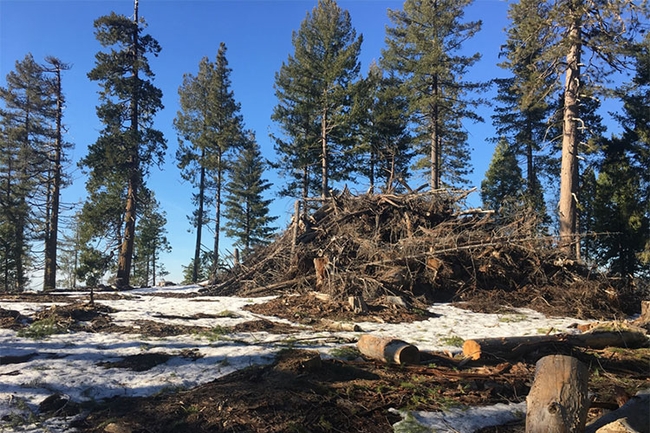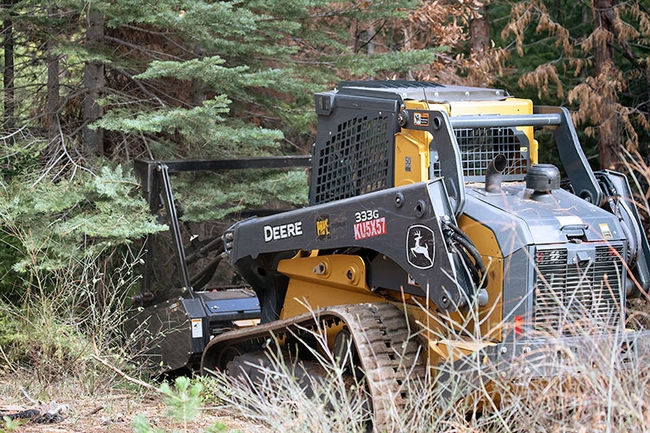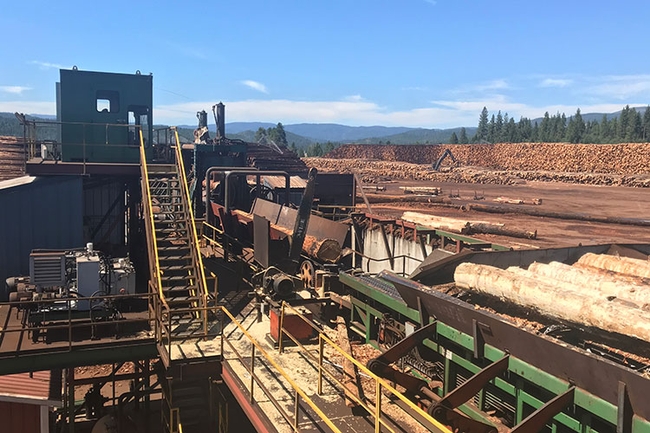
Want to limit carbon and curb wildfire? Create a market for small trees
Clearing California's forests of dense overgrowth is a critical first step for curbing catastrophic wildfire in the state. But forest restoration — whether through prescribed burning or thinning — comes at a high price: Not only are these treatments costly, but cutting down or burning vegetation can release stored carbon dioxide, accelerating the impacts of climate change.
A new analysis by researchers at the University of California, Berkeley, provides a roadmap for how the state can effectively reduce wildfire risk through forest thinning while continuing to limit its carbon emissions.
By creating a market for small diameter trees and other woody biomass — particularly by encouraging the use of long-lived “innovative wood products,” such as oriented strand board — the state can both create an economic incentive for effective forest management and prevent the carbon stored in this vegetation from entering the atmosphere.
“It's hard to manage our forests without releasing carbon,” said study first author Bodie Cabiyo, a Ph.D. candidate in UC Berkeley's Energy and Resources Group. “But if we're really efficient and careful about how we are using the wood and invest in innovative wood products that can use waste wood, then we can achieve both net carbon benefits and wildfire mitigation benefits in California.”
In 2018, former California Gov. Jerry Brown committed the state to achieving full carbon neutrality by the year 2045, a goal that will require both reducing emissions and investing in carbon sinks, such as forests, that can remove existing carbon from the atmosphere. Two years later, California and the U.S. Forest Service jointly committed to managing a total of 1 million acres of state forest land annually through thinning, prescribed burning and industrial harvesting — treatments that could send some of that carbon back into the air.
“A lot of people are pointing towards forests as a source of sucking carbon out of the air and not adding carbon to the atmosphere,” Cabiyo said. “And while the goal to manage a million acres per year is fantastic and absolutely necessary, the reality is that a million acres per year will cost a lot of money to manage, and it's still unclear where that money is going to come from.”
While data is limited on exactly how much of the state's forests are currently managed, the researchers estimate that it is currently much less than the 1 million acre-a-year target. Their analysis shows that, with the right set of policies and incentives, the use of innovative wood products could provide both the state and private landowners with necessary funding to expand forest thinning treatments while still limiting carbon emissions.
“California has been on the forefront of both climate change mitigation and adaptation,” said study senior author Daniel Sanchez, an assistant cooperative extension specialist in UC Berkeley's Department of Environmental Science, Policy, and Management. “We hope our study helps align these two goals, showing how the state can meet both its emissions reduction goals and reduce wildfire hazard, while providing a framework for managing temperate forests across the world while trying to meet the needs of a changing climate.”
Burn piles the size of school buses
To create forests that are more resilient to severe wildfire, forest managers usually focus on removing smaller trees and underbrush, leaving many of the larger and more fire-resistant trees in place. However, while larger trees can be harvested and sold to sawmills as timber, the smaller wood residues produced by forest thinning have little market value in California and are often burned or left to decay.
“If you drive through these forest treatment projects, you'll see massive burn piles that can be over 20 feet tall — the size of multiple school buses — and they're just sitting there waiting to be combusted,” Cabiyo said. “That's a lot of carbon that is going to go back into the atmosphere.”
Small trees and woody residues aren't useless, however. Industries in other parts of the world, including the southeastern U.S., create engineered lumber by mixing wood residues with adhesives and then compressing them into large sheets. This engineered lumber is strong enough for construction, and many houses in California are already built with imported engineered wood, Sanchez said.
Woody residues can also be converted in biofuel plants to create electricity or liquid fuels, and if these plants are outfitted with carbon capture technology, this energy can be produced while removing carbon dioxide from the atmosphere.
“When it comes to carbon storage or sequestration, some people focus only on what's in the forest,” Sanchez said. “We wanted to assess the carbon emissions associated with the whole life cycle of these new products.”
The study calculated future carbon emissions under both a business-as-usual scenario, assuming limited forest management, and a scenario in which the state has created a market for wood residues. To make the comparison, the researchers conducted a cradle-to-grave analysis, looking at the carbon emissions associated with every single life stage of a product — from the moment the wood is harvested until the end of the product's life.
By investing in local industries that create innovative wood products or that convert biomass into biofuels using carbon capture technology, the state could create a market for wood residues that does not add significant carbon emissions, the study found. The study also proposes a model scenario in which the state incentivizes the use of engineered wood in the construction of multi-unit affordable housing.
“If California starts doing thinning treatments at a large scale, then we're going to be producing a lot more lumber and wood residues, and where that material goes is a question,” Cabiyo said. “We found that using that new material for building affordable housing could produce massive carbon benefits, largely because those buildings otherwise would be built with steel and cement, which have significant carbon emissions associated with them.”
Thinning treatments also reduce the risk of severe wildfires that can incinerate millions of acres of vegetation at once and kill even large trees, helping California's forests maintain their long-term ability to store carbon. Study co-author Brandon Collins, a research scientist with Berkeley Forests and with the U.S. Forest Service, points out that these treatments have also been shown to provide numerous ecological benefits, including increased water availability and habitat diversity.
“Creating a market for forest biomass produced by forest thinning could reduce wildfire hazard, prevent air pollution from smoke, and potentially displace fossil fuels and increase water availability,” Collins said. “We need to deal with this small diameter biomass, and there is a solution if we could just find a way to connect the dots politically and economically.”
Additional co-authors of the study include Jeremy S. Fried of the U.S. Forest Service and William Stewart and Jun Wong of UC Berkeley. This research was supported in part by a National Science Foundation Graduate Research Fellowship and the Conservation 2.0 Program.



